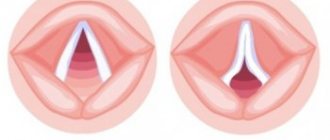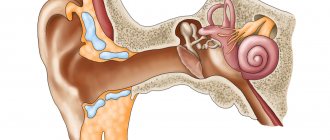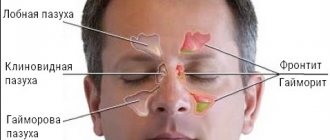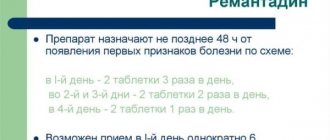Children under one year old often suffer from a variety of acute respiratory diseases and infections. This is due to the immaturity of the child's immune system. Inflammation of the larynx, or laryngitis, is especially common in children prone to allergies. In some cases, this disease requires urgent medical intervention.
Children's acute respiratory infections can develop into more dangerous diseases
What is laryngitis and laryngotracheitis
Laryngitis is an inflammation of the larynx. The disease is manifested by the following symptoms:
- redness of the throat;
- frequent dry cough that gets worse at night;
- slight increase in temperature;
- enlarged lymph nodes.
If inflammation of the trachea occurs, the infection is called laryngotracheitis. If not treated correctly, it can develop into bronchitis or pneumonia.
Laryngitis begins like any respiratory infection
Causes of laryngotracheitis, risk factors
Nervous cough in a child—symptoms, treatment
Laryngotracheitis without fever in a child is not dangerous, but at night it can cause laryngeal stenosis, or false croup. The most common causes of laryngotracheitis are the penetration of viruses into the body and allergic reactions. The risk group includes the following categories of children:
- babies under one year of age are bottle-fed and do not receive breast milk;
- frequently ill children;
- allergic infants;
- infants who have recently had contact with patients with acute respiratory infections (for example, at an appointment in a children's clinic).
The tendency to the disease does not depend on heredity.
Complications
If proper therapy is not available, the disease progresses and leads to negative consequences.
Downward spread of infection causes pneumonia and tracheobronchitis. The development of pneumonia often acts as a complication when the disease becomes chronic.
Symptoms of complications include a sharp rise in temperature, increased feeling of poor health, and worsening signs of intoxication. The cough doesn't stop. Upon examination, the doctor notes the presence of wheezing in the lungs.
The accumulation of sputum in the lumen of the larynx during a spasm of its muscles can provoke false croup in children. If obstruction develops in the background, the disease leads to asphyxia. Lack of urgent help ends in death.
Coughing on a constant basis damages and irritates the mucous membranes of the tracheopharyngeal region. Thus, chronicity can provoke tumor formation. What is even more dangerous, the hypertrophic type of the disease can cause cancer in the larynx area.
False croup in children.
Forms of the disease
Treatment of laryngotracheitis in infants depends on the form of the disease. It can be acute or chronic. In the first case, it proceeds sluggishly, worsening in the cold season (mainly in spring and autumn). In the second case, the infection has a paroxysmal form and appears suddenly. As a rule, this happens at night. Characteristic symptoms and signs of the acute form:
- loss of voice;
- cough that sounds like a dog barking;
- labored breathing;
- wheezing in the lungs.
Intracranial pressure in a child - what is it, symptoms and treatment
The onset of the disease is always unexpected for parents; this is where the main danger lies.
Attention! The most dangerous is the acute stenotic form of the disease. In this case, swelling of the larynx can cause suffocation and death.
Symptoms
Symptoms of the disease occur against the background of a cold , which is viral in nature, and are accompanied by a sore throat, runny nose, pain when swallowing, and fever. Without the necessary treatment, the acute form often develops into a chronic form, which can last a long time, periodically exacerbating.
Symptoms of acute laryngotracheitis
Symptoms of the disease in acute form in adults and children increase very quickly. Their severity depends on how severely laryngitis has affected the tissues of the larynx, and tracheitis has affected the trachea. With acute laryngotracheitis, a person experiences severe sore throat and it becomes difficult for him to swallow liquid. The patient loses his appetite, symptoms of intoxication intensify, and the overall condition worsens very much.
Characteristic symptoms of acute laryngotracheitis:
- change in voice, which becomes rough, hoarse, loses its sonority;
- dry and barking cough, worse at night and in the morning, softening as the disease progresses.
A cough can provoke laughter, a deep breath, or inhalation of cold air. After a coughing attack behind the sternum, the patient experiences pain.
Symptoms of chronic laryngotracheitis
The chronic form of the disease is characterized by a constant dry cough , a hoarse voice, and it is difficult for the patient to talk for a long time. Headaches occur, sweating increases, sleep is disturbed, appetite disappears, a sore throat begins, and a feeling of a lump in the throat appears. Before saying anything, the patient first clears his throat, and sometimes a small amount of sputum is released from the throat.
Stenotic laryngotracheitis in a child is expressed in sudden attacks of barking cough , which is accompanied by wheezing in the throat, shortness of breath, blue discoloration of the nasolabial triangle and lips. The child is usually very scared. Cold sweat, pallor may appear, and the baby is prevented from taking a horizontal position by a suffocating cough. If assistance is not provided in a timely manner, an attack of false croup can result in severe spasm of the larynx and asphyxia.
Diagnosis of the disease
TTH in newborns - what is it, symptoms and treatment
Laryngotracheitis in a child is diagnosed during an examination by a pediatrician. To make a diagnosis, the doctor examines the patient's medical history. The doctor then examines the child's throat and listens to his breathing. Laryngotracheitis is characterized by the presence of so-called “dry” wheezing. Additionally, the doctor may prescribe:
- general urine analysis;
- blood analysis;
- fluorography or x-ray to exclude the possibility of developing pneumonia.
Important! Making a diagnosis yourself, without waiting for a doctor’s examination, is strictly prohibited. Parents can only alleviate the baby’s condition, but the pediatrician prescribes treatment.
The main sign of laryngitis is severe redness of the throat
Why does laryngotracheitis occur?
The acute form of laryngotracheitis is usually viral in nature. The causative agents are viruses that cause acute respiratory viral infection or influenza. In some cases, laryngotracheitis may be a consequence of chickenpox or rubella, but this happens extremely rarely, and only in childhood. Bacteria (staphylococci, streptococci, pneumococci) can also become pathogens. This can only be determined by a clinical blood test.
An important role in the development of the disease is played by the general condition of the body and the presence of concomitant pathologies, which significantly reduce physiological protection against infections. These factors include:
- chronic pathologies of the respiratory system;
- autoimmune disorders;
- diabetes;
- difficulty breathing through the nose;
- congestion in the lungs;
- severe hypothermia;
- constant smoking and alcohol abuse;
- chemical, thermal, mechanical damage to the mucous membrane and tissues of the larynx;
- seasonal, household, drug allergies.
In childhood, laryngotracheitis occurs due to the rapid progression of the infectious process, and in adults it is often a consequence of negligent attitude towards health. Self-treatment, non-compliance with bed rest, and bad habits complicate the common cold - this is how the pathology becomes chronic. Chronic laryngotracheitis is characterized by erased symptoms with constant relapses. The trigger can be simple hypothermia, drinking cold water, or any disease that reduces immunity.
In order to prevent the development of laryngotracheitis, and even more so its chronicity, it is necessary to promptly treat throat diseases and lead a healthy lifestyle.
What symptoms indicate the development of laryngotracheitis
Laryngotracheitis is a collective concept of laryngitis and tracheitis, which develop simultaneously. Therefore, the symptoms include manifestations of both diseases. The disease develops gradually, so it is almost impossible to suspect it at the first signs. Soreness, burning and rawness in the throat are characteristic of any pathology of the larynx. Only with the addition of more indicative symptoms and on the basis of differential diagnosis can an accurate diagnosis be made.
The following signs are indicative of acute laryngotracheitis:
- increase in body temperature to 38-39°;
- rawness and soreness in the chest, especially when coughing;
- dry, turning into wet, cough with barking sounds;
- hoarseness of voice, tension of ligaments when speaking;
- noisy breathing with wheezing;
- swelling and tenderness of the submandibular lymph nodes;
- coughing attack after taking a deep breath or laughing;
- sputum when expectorated is viscous and thick, over time it can become purulent;
- feeling of lack of air or foreign body due to tracheal edema;
- general signs of intoxication are chills, fever, muscle pain, weakness, lethargy.
All these symptoms are not necessarily present in combination, but are characteristic of the acute course of laryngotracheitis. The appearance of at least one of them, especially against the background of an acute respiratory infection, should alert you and serve as an indication to consult a doctor.
Chronic laryngotracheitis occurs in adults. Its symptoms are rather vague and unremarkable. This form of the disease is characterized by problems with the voice, because the inflammatory process in the larynx primarily affects the vocal cords, disrupting their functionality. The voice may periodically disappear or become hoarse. A slight cough appears, more like a constant cough. Unpleasant sensations and rawness in the thoracic region, which occur periodically, indicate a chronic process. These symptoms appear especially clearly after hypothermia or nervous strain.
It is important to pay attention to even minor discomfort in the throat, then the disease is diagnosed in the early stages and completely cured. In the case of advanced variants, serious complications are possible in the form of a retropharyngeal abscess, laryngospasm, laryngeal obstruction, and pneumonia.
First aid
If a baby has laryngotracheitis, the doctor will tell you how to treat the child. Self-medication can be very dangerous, as can inaction. To provide first aid you need:
- sit the little one in an upright position to make it easier for him to breathe;
- give the baby an antihistamine in an age-appropriate dosage to relieve laryngeal swelling;
- if the child is breathing with wheezing, give him inhalation using any inhaler for patients with bronchial asthma;
- Give the baby something to drink to make it easier for him to cough up thick mucus.
If you have a barking cough and loss of voice, you should immediately call an ambulance.
Loss of voice in a baby is an alarming signal
Attention! If the child has difficulty breathing, you should open the windows in the apartment and, if possible, go out into the fresh air with the baby. You can also go into the bath with your baby and turn on the hot water. Steam helps improve airway patency and expands the bronchi.
Treatment of laryngotracheitis
The general approach to treating the disease is approximately the same as when treating other acute respiratory viral infections. The child is given antiviral drugs that increase immunity, and cough medicines that thin sputum. The temperature is not brought down below 38 degrees, because this is how the body’s protective reaction manifests itself when encountering the virus.
The correct regimen for treating the disease
If laryngotracheitis in an infant occurs without elevated body temperature, the child may not be limited in movements. At temperatures above 38 degrees, the baby should be given an antipyretic. Also, to organize the correct regime it is necessary:
- Ventilate the room in which the baby is located several times a day;
- temporarily do not bathe the baby until he recovers;
- give the baby to drink as much fluid as possible;
- Do not allow the child to cry for a long time, so as not to increase throat irritation.
Walking is not prohibited if it is warm outside and the child’s temperature is below 38 degrees. You should not go outside in winter, because cold air entering the lungs can worsen the course of the disease.
If there is no temperature, the baby does not need bed rest
What not to do
It is strictly not recommended to treat your baby with various herbal remedies (herbal infusions and decoctions). Laryngotracheitis often occurs in children prone to allergies, so any herbal medications can aggravate the disease, provoking an undesirable reaction. For the same reason, you should not lubricate your baby’s chest with warming ointments that relieve coughing, and you should not give honey inside.
Before using any folk remedies, you should consult a pediatrician. Also, you should not inhale the steam from boiled potatoes, because this can cause the child to get a burn to the respiratory tract. Inhalations for tracheitis at home can only be done using a special device - a nebulizer, in accordance with the recommendations of the pediatrician.
Laryngotracheitis in children: treatment at home
There are some general rules for treating laryngotracheitis in children at home:
- Keep the windows and doors of the child's room open so that there is always fresh air. Close windows and doors after 10-15 minutes of ventilation.
- Over-the-counter medications, such as ibuprofen or acetaminophen, can be purchased in advance to treat a fever.
Warm and clear liquids are necessary to be taken orally, as they reduce mucus secretion. For children older than four months, lemonade, apple juice or just warm water are suitable for treating laryngotracheitis at home.- Smoking near a sick child is strictly prohibited, as even one cigarette can significantly worsen the signs of the disease.
- If a child needs to get out of bed, parents should monitor the child's position. Try to keep your back straight; use a pillow to make things easier with naughty children.
- Parents are advised to sleep with the baby in their room as they may need something during worsening symptoms of laryngotracheitis or a coughing attack.
Important
The famous doctor Komarovsky in the treatment of laryngotracheitis in children suggests the absence of antibiotics whenever possible. All treatment should be based on bed rest, plenty of fluids and fresh air. In severe forms of laryngotracheitis, such treatment is unacceptable.
Emergency care in the treatment of laryngotracheitis in children at home
Parents should be vigilant in cases of emergency, especially if the child develops acute stenosing laryngotracheitis. The main medications in this case are a glucocorticosteroid in combination with humidified air. Dexamethasone is the main drug in treatment and is administered either orally or intravenously. The effectiveness of this drug in the treatment of moderate laryngotracheitis has been noted.
It is better not to treat laryngotracheitis with folk remedies at home, since herbs can only become irritants.
If parents notice that croup is developing to a serious stage, they consult a doctor. All conditions and signs of laryngotracheitis are examined only in a doctor’s office. Compared to moderate manifestations of laryngotracheitis, more severe manifestations can lead to serious consequences that can become life-threatening for the child.
The doctor must monitor the child's oxygen levels, skin color, heart rate and breathing rate in order to prescribe the correct treatment. If progress in treatment is not observed, then the dosage of drugs is increased.
Recommendations of Dr. Komarovsky
When asked how to treat laryngotracheitis in a child, Komarovsky replies that antibiotics are ineffective in this case, because the disease is most often caused by viruses. Komarovsky argues that the main thing with laryngotracheitis is to relieve an attack of stenosis, which is manifested by a barking cough and respiratory failure at night. After this, you can follow the same tactics that parents usually use when treating a common acute respiratory infection. If you do everything correctly, the disease will go away in seven to ten days without complications and will not happen again. However, weakened children can suffer from laryngotracheitis several times per season.
Komarovsky also claims that you should not buy expensive cough syrups to thin sputum. It is enough to simply increase the amount of liquid the child drinks, after which the thickness of the mucus will decrease and the baby will breathe easier. Also, if there is increased mucus production, you can give the child a special massage to help the mucus drain better. With the right regimen, curing the disease is not difficult.
Disease prevention
To prevent the disease, it is necessary to monitor the baby’s nutrition, walk with him as often as possible, and include hardening procedures in the regime. During the cold season, you should not visit crowded places with your child, as the disease is transmitted by airborne droplets through contact with sick people. The following recommendations will also be helpful:
- Always dress your baby appropriately for the weather and do not wrap him up to prevent excessive sweating;
- when the time comes to introduce complementary foods, you need to do this very carefully so as not to cause a food allergy in the child;
- up to a year, completely eliminate strong allergens (nuts, chocolate and citrus fruits) from the diet;
- do not give your baby cold drinks and ice cream;
- Do not give your baby drinks that are too hot, because the increased temperature of the liquid also irritates the throat.
These simple recommendations will help you avoid a dangerous disease. If laryngotracheitis is confirmed, the baby will endure it in a mild form, without dangerous laryngeal stenosis. You can be treated at home, without hospitalization.
If your child suddenly develops a cough, especially at night, there is no need to panic. The main thing is to monitor the baby's breathing in order to quickly take action if necessary. If you consult a doctor in a timely manner, laryngitis can be successfully treated and does not cause complications. The same can be said about laryngotracheitis.
Causes
Quite often, the respiratory system is affected by an acute respiratory viral infection . When complications occur, tracheitis or laryngitis develops, which is an inflammatory process that occurs on the mucous membrane of the larynx. Then tracheitis, characterized by inflammation of the trachea, may appear. The simultaneous development of laryngitis and tracheitis causes laryngotracheitis.
Commonly encountered viral diseases are those observed in chickenpox, ARVI, influenza, parainfluenza, measles, rubella, scarlet fever, and adenoviral infection. Bacterial laryngotracheitis is caused by staphylococcus, streptococcus, pneumococcus. Both adults and children become infected from a sick person through airborne droplets, especially if he sneezes or coughs.
Favorable factors provoking the development of laryngotracheitis are:
- congestion of the respiratory tract;
- weakened state of the human body due to chronic diseases or hypothermia;
- air that is too cold, hot, humid or dry;
- constant breathing through the mouth due to impaired nasal breathing due to a deviated nasal septum, chronic allergic rhinitis, sinusitis, choanal atresia and other sinusitis;
- smoking;
- occupational hazards, for example, the presence of irritating substances in the air, dustiness, increased vocal or respiratory stress.
It is worth considering separately the causes of acute stenotic laryngotracheitis in a child. This disease is also called false croup - it is a stenosis of the larynx that can cause asphyxia. Such a narrowing of the lumen of the larynx in a child can develop due to swelling, spasm of the muscles of the trachea and larynx. As a result, the flow of air into the lungs with all the ensuing consequences is reduced.










